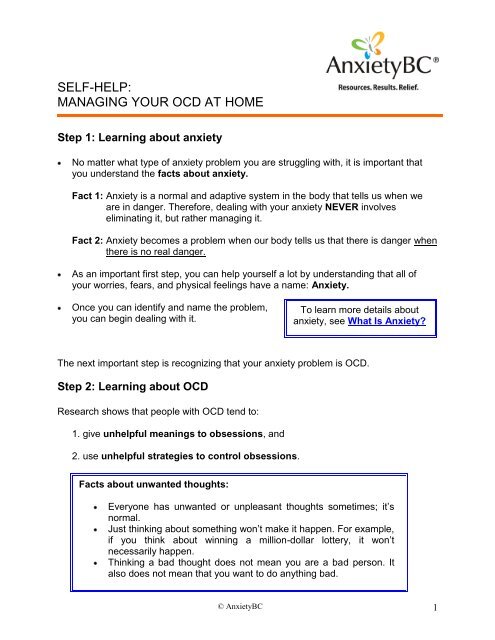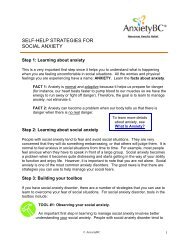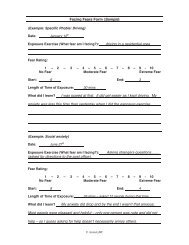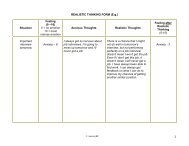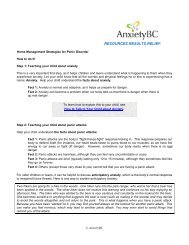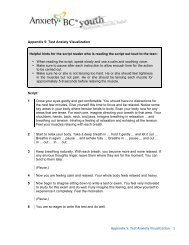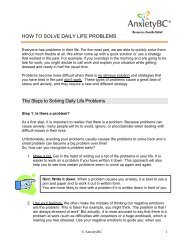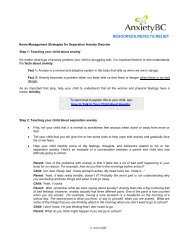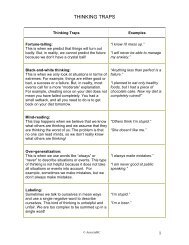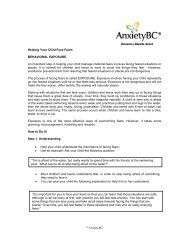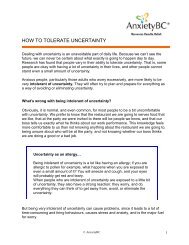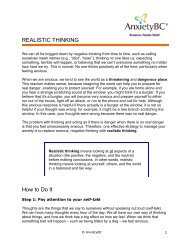Self-Help: Managing your OCD at Home - AnxietyBC
Self-Help: Managing your OCD at Home - AnxietyBC
Self-Help: Managing your OCD at Home - AnxietyBC
You also want an ePaper? Increase the reach of your titles
YUMPU automatically turns print PDFs into web optimized ePapers that Google loves.
SELF-HELP:<br />
MANAGING YOUR <strong>OCD</strong> AT HOME<br />
Step 1: Learning about anxiety<br />
No m<strong>at</strong>ter wh<strong>at</strong> type of anxiety problem you are struggling with, it is important th<strong>at</strong><br />
you understand the facts about anxiety.<br />
Fact 1: Anxiety is a normal and adaptive system in the body th<strong>at</strong> tells us when we<br />
are in danger. Therefore, dealing with <strong>your</strong> anxiety NEVER involves<br />
elimin<strong>at</strong>ing it, but r<strong>at</strong>her managing it.<br />
Fact 2: Anxiety becomes a problem when our body tells us th<strong>at</strong> there is danger when<br />
there is no real danger.<br />
As an important first step, you can help <strong>your</strong>self a lot by understanding th<strong>at</strong> all of<br />
<strong>your</strong> worries, fears, and physical feelings have a name: Anxiety.<br />
Once you can identify and name the problem,<br />
you can begin dealing with it.<br />
The next important step is recognizing th<strong>at</strong> <strong>your</strong> anxiety problem is <strong>OCD</strong>.<br />
Step 2: Learning about <strong>OCD</strong><br />
Research shows th<strong>at</strong> people with <strong>OCD</strong> tend to:<br />
1. give unhelpful meanings to obsessions, and<br />
2. use unhelpful str<strong>at</strong>egies to control obsessions.<br />
Facts about unwanted thoughts:<br />
To learn more details about<br />
anxiety, see Wh<strong>at</strong> Is Anxiety?<br />
Everyone has unwanted or unpleasant thoughts sometimes; it’s<br />
normal.<br />
Just thinking about something won’t make it happen. For example,<br />
if you think about winning a million-dollar lottery, it won’t<br />
necessarily happen.<br />
Thinking a bad thought does not mean you are a bad person. It<br />
also does not mean th<strong>at</strong> you want to do anything bad.<br />
© <strong>AnxietyBC</strong> 1
Unhelpful meanings given to obsessions<br />
If everyone has unwanted thoughts from time to time, how come everyone doesn’t have<br />
<strong>OCD</strong>? It is because of the interpret<strong>at</strong>ion or meaning th<strong>at</strong> you give to the thought. The<br />
meaning you give to an unwanted thought can turn it into an obsession, which happens<br />
much more frequently and with gre<strong>at</strong>er intensely.<br />
For example, let’s say th<strong>at</strong> you had the following unwanted thought: “Wh<strong>at</strong> if I pushed<br />
someone into traffic?” If you said to <strong>your</strong>self, “Th<strong>at</strong>’s a terrible thought! But I know th<strong>at</strong> it<br />
doesn’t mean anything, and I know I wouldn’t do th<strong>at</strong>”, then you would probably not<br />
develop <strong>OCD</strong>. On the other hand, if you said to <strong>your</strong>self, “Why did I think th<strong>at</strong>? Maybe<br />
this means th<strong>at</strong> I am a dangerous person!” then you increase <strong>your</strong> chances of<br />
developing <strong>OCD</strong>: <strong>your</strong> interpret<strong>at</strong>ion of <strong>your</strong> thought as important, meaningful, and<br />
dangerous will make you have more of these unwanted thoughts.<br />
Please see Unhelpful Interpret<strong>at</strong>ions of Obsessions<br />
sheet for detailed inform<strong>at</strong>ion on some unhelpful meanings<br />
commonly given to obsessions.<br />
Unhelpful str<strong>at</strong>egies to control obsessions<br />
When you see <strong>your</strong> intrusive unwanted thoughts as thre<strong>at</strong>ening or dangerous and<br />
causing you a lot of anxiety, it is not surprising th<strong>at</strong> you want to get rid of them! However,<br />
most of the str<strong>at</strong>egies th<strong>at</strong> you use to control <strong>your</strong> obsessions can inadvertently push<br />
you into traps th<strong>at</strong> will make <strong>your</strong> <strong>OCD</strong> worse.<br />
Trap 1: All the str<strong>at</strong>egies you use (e.g., checking, seeking reassurance,<br />
washing, avoidance) don’t work, because <strong>your</strong> anxiety only goes down<br />
for a short time and comes back again. But, because they do work in the<br />
short term, you are likely to use them again the next time you have an<br />
obsession. By doing so, you never get a chance to learn more effective<br />
str<strong>at</strong>egies to manage <strong>your</strong> obsessions.<br />
Trap 2: Using these str<strong>at</strong>egies also does not give you a chance to find out<br />
whether the meaning or interpret<strong>at</strong>ion you gave to the obsessions was<br />
really correct.<br />
Trap 3: These str<strong>at</strong>egies produce the opposite effect you wish to achieve.<br />
Th<strong>at</strong> is, even though you hoped these str<strong>at</strong>egies would help you to<br />
control the obsessions, they actually make you think about the<br />
obsessions even more often!<br />
© <strong>AnxietyBC</strong> 2
The vicious cycle of <strong>OCD</strong><br />
Let’s say you have an unpleasant thought (for example, having a thought of stabbing<br />
<strong>your</strong> spouse) th<strong>at</strong> happens to “pop” into <strong>your</strong> head. If you <strong>at</strong>tach unhelpful meanings to<br />
the thought (for example, “having this thought means I’m an evil person who is capable<br />
of murdering a loved one”), you will probably feel very anxious as a result.<br />
Now, because it is uncomfortable to be anxious, you are likely to find ways to lessen th<strong>at</strong><br />
anxiety. For example, you may repe<strong>at</strong>edly check to make sure the drawer where you<br />
store all the sharp objects (e.g., scissors, knives) is locked and say a prayer to <strong>your</strong>self<br />
every time you have the “bad” thought.<br />
Unfortun<strong>at</strong>ely, you find th<strong>at</strong> even though these str<strong>at</strong>egies help you to briefly lessen the<br />
anxiety, you need to do them more and more often because <strong>your</strong> “bad” thought seems<br />
to occur even more frequently when you try hard not to have it. You feel trapped<br />
because you do not know wh<strong>at</strong> else to do but keep using these str<strong>at</strong>egies! The next<br />
thing you know, <strong>your</strong> life is being consumed by the “bad” thought and <strong>your</strong> constant<br />
efforts to control it. This is how the vicious cycle of <strong>OCD</strong> develops and keeps going!<br />
Trigger<br />
Obsession<br />
Meaning you give to the obsession<br />
Anxiety<br />
Str<strong>at</strong>egies used to cope with the obsessions<br />
(They are Compulsions and other unhelpful behaviours)<br />
Step 3: Building <strong>your</strong> <strong>OCD</strong> Management Toolbox<br />
The best way to begin managing <strong>your</strong> <strong>OCD</strong> is to begin building a toolbox of str<strong>at</strong>egies<br />
th<strong>at</strong> will help you to deal with <strong>your</strong> obsessions in the long run.<br />
Breaking this vicious cycle involves: (1) Learning to gradually elimin<strong>at</strong>e <strong>your</strong><br />
unhelpful coping str<strong>at</strong>egies (such as compulsions); and (2) Learning to think<br />
about <strong>your</strong> obsessions in a more balanced and helpful way.<br />
Here are some effective tools to help you break the cycle of <strong>OCD</strong>:<br />
© <strong>AnxietyBC</strong> 3
TOOL # 1: FACING FEARS - EXPOSURE AND RESPONSE<br />
PREVENTION (ERP)<br />
Learning to gradually face <strong>your</strong> fears is one of the most effective ways to break<br />
the <strong>OCD</strong> cycle. For <strong>OCD</strong>, the technique for facing fears is called exposure and<br />
response prevention (ERP).<br />
ERP is done by:<br />
o Exposing <strong>your</strong>self to situ<strong>at</strong>ions th<strong>at</strong> bring on obsessions (triggers)<br />
o Not engaging in the unhelpful coping str<strong>at</strong>egies (compulsions or avoidance).<br />
How to Do It<br />
1. Get to know <strong>your</strong> <strong>OCD</strong> better<br />
o To face <strong>your</strong> fears, it is helpful to know wh<strong>at</strong> you are thinking (<strong>your</strong> obsessions)<br />
and identify the triggers th<strong>at</strong> bring on <strong>your</strong> obsessions and compulsions.<br />
o You can do so by keeping track of the triggers on a daily basis for one week by<br />
using the Obsessive Fear Monitoring Form.<br />
o Because obsessions can happen frequently, writing down 3 triggers per day (i.e.,<br />
one in the morning, one in the afternoon, and one in the evening) will be enough<br />
to give you a good overview of <strong>your</strong> obsessions and compulsions.<br />
o In the column labelled “Fear”, r<strong>at</strong>e how intense the fear was in the specific<br />
situ<strong>at</strong>ion. Use a 0 to 10 r<strong>at</strong>ing scale, where 0 = no fear and 10 = extreme fear.<br />
o Finally, record all the compulsions/coping str<strong>at</strong>egies you used in response to the<br />
obsession. Be sure to include both behavioural and/or mental str<strong>at</strong>egies you used<br />
to manage the obsession and fear.<br />
Here’s an example to help you out<br />
D<strong>at</strong>e<br />
Nov.30<br />
Triggers for Obsessions<br />
(specific situ<strong>at</strong>ions, objects,<br />
people, or thoughts th<strong>at</strong><br />
provoke obsessive fears)<br />
Used the grocery store pen<br />
to sign the credit card<br />
receipt.<br />
Obsession<br />
This pen is covered with<br />
germs from strangers. I<br />
could contract some<br />
terrible disease and pass it<br />
on to my children, causing<br />
them to be sick.<br />
Fear<br />
(0 -10)<br />
Compulsions/<br />
Coping str<strong>at</strong>egies<br />
© <strong>AnxietyBC</strong> 4<br />
8<br />
Scrubbed each<br />
finger carefully and<br />
washed for 3<br />
minutes.
2. Build a fear ladder<br />
Try to make an entry as soon as possible after the episode as this will help<br />
you to be more precise. You may want to keep a small notebook with you<br />
th<strong>at</strong> you can easily carry around.<br />
o After about one week of tracking <strong>your</strong> obsessions and compulsions, you are<br />
ready to make a list of all the different situ<strong>at</strong>ions th<strong>at</strong> you fear.<br />
o Build a fear ladder by rank ordering <strong>your</strong> triggers from least scary to most scary.<br />
For example, if you have contamin<strong>at</strong>ion fears, being <strong>at</strong> a friend’s apartment may<br />
be a situ<strong>at</strong>ion th<strong>at</strong> is low on the fear ladder because it only evokes a fear of 1/10.<br />
But, using the b<strong>at</strong>hroom in a shopping mall may be a situ<strong>at</strong>ion th<strong>at</strong> is very high on<br />
the ladder because it evokes a 9/10 fear. See Examples of Fear Ladders for<br />
some ideas about building <strong>your</strong> fear ladder.<br />
TIP: Build a separ<strong>at</strong>e ladder for each of <strong>your</strong> obsessive<br />
fears. For example, you may need a separ<strong>at</strong>e hierarchy<br />
for all situ<strong>at</strong>ions rel<strong>at</strong>ed to <strong>your</strong> fear of contamin<strong>at</strong>ion. You<br />
may also need a separ<strong>at</strong>e ladder for all situ<strong>at</strong>ions rel<strong>at</strong>ed<br />
to <strong>your</strong> fear of causing something terrible to happen.<br />
3. Climbing the fear ladder – Exposure & Response Prevention<br />
o Once you have built a fear ladder, you are now ready<br />
to face <strong>your</strong> fears by putting <strong>your</strong>self in situ<strong>at</strong>ions th<strong>at</strong><br />
bring on <strong>your</strong> obsessions (exposure) while resisting<br />
doing anything to control the obsessions and the<br />
anxiety associ<strong>at</strong>ed with them (response prevention).<br />
How to do Exposure (see Facing <strong>your</strong> Fears: Exposure for more tips)<br />
TIP: Feeling anxious<br />
when you try these<br />
exercises is a sign<br />
th<strong>at</strong> you are on the<br />
right track!<br />
i. Bottom up. Start with the easiest item on the fear ladder first (i.e., fear=2/10) and<br />
work <strong>your</strong> way up.<br />
ii. Track progress. Track <strong>your</strong> anxiety level throughout the exposure exercise in<br />
order to see the gradual decline in <strong>your</strong> fear of a particular situ<strong>at</strong>ion. Use the<br />
Facing Fears Form to help you do this.<br />
© <strong>AnxietyBC</strong> 5
iii. Don’t avoid. During exposure, try not to engage in subtle avoidance (e.g.,<br />
thinking about other things, talking to someone, touching the doorknob only with<br />
one finger instead of the whole hand, etc.). Avoidance actually makes it harder to<br />
get over <strong>your</strong> fears in the long run.<br />
iv. Don’t rush. It is important to try to stay in the<br />
situ<strong>at</strong>ion until <strong>your</strong> fear drops by <strong>at</strong> least one-half<br />
(e.g., from 6/10 to 3/10). Also, focus on<br />
overcoming one fear <strong>at</strong> a time. It is a good idea to<br />
do the exposure repe<strong>at</strong>edly until the first item on<br />
the hierarchy no longer causes much of a<br />
problem for you.<br />
How to do Response Prevention<br />
i. Resist the urge. In order for exposure to work, it is important th<strong>at</strong> you try to resist,<br />
as much as possible, carrying out <strong>your</strong> compulsions during or after the exposure.<br />
The whole point of ERP is to learn to face <strong>your</strong> fear without having compulsions.<br />
ii. Modeling. If you have been performing compulsions for some time, it may be<br />
difficult to know how to face a feared situ<strong>at</strong>ion without doing them. In this case, it<br />
can be helpful to ask a family member or a close friend who does not have <strong>OCD</strong><br />
to show you how to, for example, wash hands quickly or leave home without<br />
rechecking appliances, and then model their behaviour.<br />
iii. Delaying and reducing ritualizing as an altern<strong>at</strong>ive. You might find it very<br />
difficult to completely resist a compulsion, especially the first time you are facing<br />
<strong>your</strong> fears. In th<strong>at</strong> case, you can try to delay acting on the compulsion r<strong>at</strong>her than<br />
not doing it <strong>at</strong> all. For example, after touching the floor (exposure), wait for 5<br />
minutes before washing <strong>your</strong> hands, and wash for 1 minute instead of 3 minutes.<br />
Try to gradually prolong the delay, so th<strong>at</strong> you can eventually resist the<br />
compulsion altogether.<br />
iv. Re-exposure. If you do end up performing a compulsion, try to re-expose<br />
<strong>your</strong>self to the same feared situ<strong>at</strong>ion immedi<strong>at</strong>ely, and repe<strong>at</strong> the practice until<br />
<strong>your</strong> fear drops by one-half. For example, Practice 1: touch the floor and wait for<br />
5 minutes before washing hands for 1 minute. Practice<br />
2: touch the floor again immedi<strong>at</strong>ely after washing,<br />
and wait for another 5 minutes before washing for 1<br />
minute. Repe<strong>at</strong> this process until <strong>your</strong> anxiety drops<br />
from, say, 6/10 to 3/10.<br />
TIP: Regardless of its<br />
intensity, a fear will peak<br />
and then level off. If you do<br />
nothing about it, the fear will<br />
eventually go away on its<br />
own.<br />
Two Keys to ERP:<br />
Gradual &<br />
Consistent!<br />
v. How to move on. Once you experience only a little anxiety when completing an<br />
exercise, you can move on to the next one. For example, after several practices,<br />
you might feel very little anxiety when you wait 5 minutes to wash <strong>your</strong> hands<br />
after touching the floor. You can then challenge <strong>your</strong>self to wait for 8 minutes<br />
© <strong>AnxietyBC</strong> 6
efore washing <strong>your</strong> hands after touching the floor. Again, repe<strong>at</strong> this practice<br />
until <strong>your</strong> anxiety drops by one-half.<br />
REMEMBER: It is O.K. to ask for help! Talk to a supportive person<br />
when you have the urge to perform a compulsion and are afraid th<strong>at</strong><br />
you can’t resist it. Ask this person to stay with you or to go somewhere<br />
with you until the urge decreases to a manageable level.<br />
TOOL #2: CHALLENGING UNHELPFUL INTERPRETATIONS<br />
OF OBSESSIONS<br />
This technique is a good tool to use in combin<strong>at</strong>ion with Exposure and Response<br />
Prevention to address the upsetting thoughts th<strong>at</strong> are a part of <strong>OCD</strong>. See How to<br />
Effectively Manage Obsessions for more detailed inform<strong>at</strong>ion.<br />
TOOL #3: MANAGING YOUR STRESS<br />
Because it is hard work to manage <strong>OCD</strong>, <strong>your</strong> progress will not always be smooth. Also,<br />
<strong>your</strong> <strong>OCD</strong> can be stronger when you are under stress. Therefore, it is helpful to develop<br />
a list of potentially stressful situ<strong>at</strong>ions (e.g., argument with loved ones, extra<br />
responsibilities <strong>at</strong> work) th<strong>at</strong> might make <strong>your</strong> <strong>OCD</strong> worse. Anticip<strong>at</strong>e <strong>your</strong> stressors<br />
so you feel more prepared when they happen. It is also a good idea to actively reduce<br />
<strong>your</strong> stress and lead a healthy lifestyle. Please see Healthy Living and Problem<br />
Solving for helpful tips.<br />
Step 4: Building on Bravery<br />
Learning to manage anxiety takes a lot of hard work. If you are noticing improvements,<br />
take some time to give <strong>your</strong>self some credit: reward <strong>your</strong>self!<br />
How do you maintain all the progress you’ve made? Practise! Practise! Practise!<br />
The <strong>OCD</strong> management skills presented here are designed to teach you new and more<br />
effective ways of dealing with <strong>your</strong> obsessions and compulsions. If you practice them<br />
often, you will find th<strong>at</strong> <strong>your</strong> obsessive fears have a weaker and weaker hold over you.<br />
Learning to manage anxiety is a lot like exercise – you need to “keep in shape” and<br />
practice <strong>your</strong> skills regularly. Make them a habit, even after you are feeling better and<br />
you have reached <strong>your</strong> goals.<br />
For more inform<strong>at</strong>ion on how to maintain <strong>your</strong> progress and how to cope with relapses in<br />
symptoms, see How to Prevent a Relapse.<br />
© <strong>AnxietyBC</strong> 7


